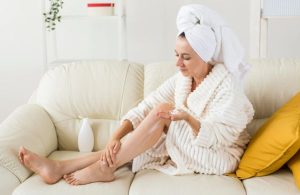The personal care industry is plenty of different types of creams and lotions suitable for all kind of skins, characterized by various texture, fluidity, and level of absorption on the skin.
An accurate quality control of the formulation is essential to provide products that are pleasant for the consumer, that provide a smooth and soft skin effect and, more importantly, a long-lasting hydration.
The investigation of the rheological behavior of moisturizers can help to evaluate the structure, the stability and the spreadability of the formulation, avoiding customer claims or destabilization issues.
A good test to start with is the oscillatory test that provides an overview of the structural integrity of the sample and allows to assess the selfstorage stability: as reported in Figure 1, the comparison of two body milks shows that product B has a slightly larger Linear Visco-Elastic Region (LVER), that is the range where the storage modulus G’ and the viscous modulus G’’ are constant. A subsequent drop of the elastic component G’ reveals the breakage of the structure.

Figure 1 – Amplitude sweep test. Comparison of Body Milk A (red line) and Body Milk B (blue line).
The structural strength is correlated with the yield stress, the stress that must be applied to allow the sample to flow. The yield point can be determined in different ways, for example performing a shear stress ramp: the peak in viscosity indicates the point where the structure breaks down (Figure 2). Figure 2 shows that sample B has a higher yield point

Figure 2 – Determination of the Yield Stress. Comparison of Body Milk A (red line) and Body Milk B (blue line)
The flow and regeneration behaviors, that emerge for example when squeezing a tube containing the product, can be assessed with a structure and recovery test, as shown in figure 3, and it’s a way to characterize the time-dependance behavior of the sample or the so-called thixotropic behavior. The test is divided in three defined steps: the first one evaluates the behavior at rest, in the second step is induced a structural decomposition at high shear rate, while the last one shows the structural regeneration. In the example reported, the body milk B shows a higher recovery then the body milk A (Figure 3), that is therefore revealed to be more thixotropic.

Figure 3 – Structure and Recovery test. Comparison of Body Milk A (red line) and Body Milk B (blue line).
The spreadability can be determined from the viscosity curve. Considering cosmetic creams and lotions, the viscosity is usually dependent on the shear intensity, meaning that they have a shear-thinning behavior, as shown in Figure 4. Comparing the two products, the body milk A shows lower viscosity values, which means that it can be spread easier onto the skin than the body milk B.

Figure 4 – Viscosity curves. Comparison of Body Milk A (red line) and Body Milk B (blue line).





